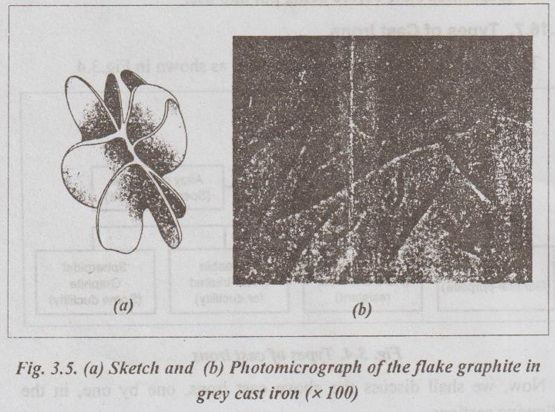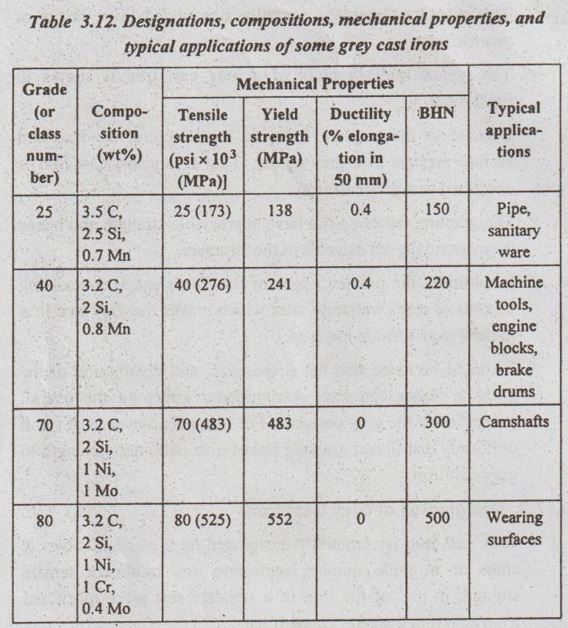Grey cast iron is the least expensive and the most common type of cast iron.
GREY CAST IRON
1. What is Grey Cast Iron?
✓ Grey cast iron is the least expensive and the most common type of cast iron.
✓ It is an alloy of carbon and silicon with iron.
✓ Composition: Typical composition of grey cast iron is given below:
Carbon - 2.5 to 4%
Silicon - 1 to 3%
Manganese - 0.4 to 1%
Phosphorus - 0.15 to 1%
Sulphur - 0.02 to 0.15%
Remaining is iron
2. Microstructure of Grey Cast Iron
✓ The microstructure of grey cast irons consist of graphite flakes, which resemble a number of potato crisps glued together at a single location, as shown in Fig.3.5 (a).

✓ This graphite flakes are normally surrounded by a ferrite or pearlite matrix.
✓ The typical microstructure of a grey cast iron is shown in Fig.3.5 (b).
✓ Because of the graphite flakes in the structure, the fractured surface appears in a grey colour. That's why this cast iron is described as a grey cast iron.
✓ The graphite flakes do not have appreciable strength and hence they essentially act as voids in the structure.
✓ In addition, the pointed edges of the flakes act as preexisting notches or crack initiating sites which makes the grey cast iron to behave as a brittle material.
✓ It should be noted that the shape, size, and distribution of the graphite flakes can have a significant effect on the overall properties of the grey cast iron. For instance, presence of small uniformly distributed graphite flakes give maximum strength to grey cast iron.
3. Designation of Grey Cast Iron
✓ Grey cast iron is commonly designated by a grade number. A class or a grade number represents the minimum tensile strength in psi↑ of the iron in a standard test piece machined from a 30 mm diameter cast test bar.
✓ For example, a class (or a grade) 20 iron means the cast iron has minimum tensile strength of 20 × 103 psi (≈ 138 MPa↑↑); and a class 40 iron means the cast iron has minimum tensile 25m strength of 40 × 103 psi (≈ 276 MPa).
✓ Table 3.12 presents the typical compositions and mechanical properties of some grey cast irons.
† psi refers the unit pounds per square inch.
†† Multiply psi by 6.9 × 103 to obtain MPa.

4. Characteristics of Grey Cast Iron
The important properties of grey cast irons are given below:
1. Grey cast iron possess excellent compressive strengths. In fact, the compressive strength of grey cast iron is three to five times higher than its tensile strength. This is due to the fact that compressive forces do not promote crack propagation.
2. It also has good torsional and shear strengths.
3. It has good corrosion resistance, which may be attributed to high silicon content.
4. It has excellent fluidity and hence it can be cast into any complex shapes.
5. It posses good wear resistance in adhesive wear conditions. This is due to the presence of graphite flakes which provide self lubrication.
6. It exhibits excellent machinability (better than steel). This is because graphite acts to break up the chips and lubricate contact surfaces.
7. It also has outstanding sound and vibration damping capacity. This is again due to the fact that graphite flakes absorbs transmitted energy.
5. Applications of Grey Cast Iron
The typical applications of grey cast irons include machine tool bodies, engine blocks, engine cylinders, brake drums, cam shafts, pipes and pipe fittings, rolling mills, ingot moulds, household and agricultural appliances, etc.
No comments:
Post a Comment